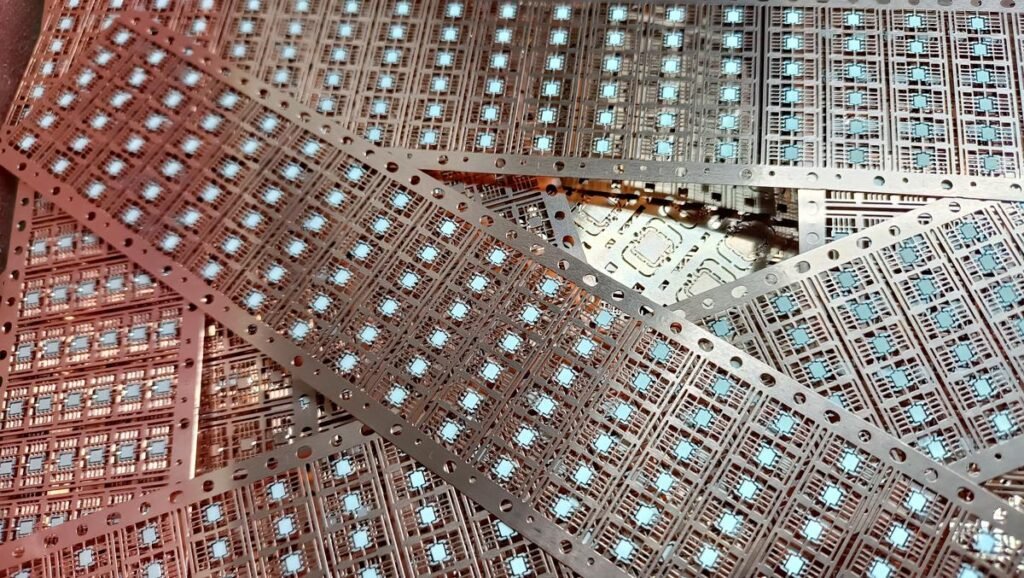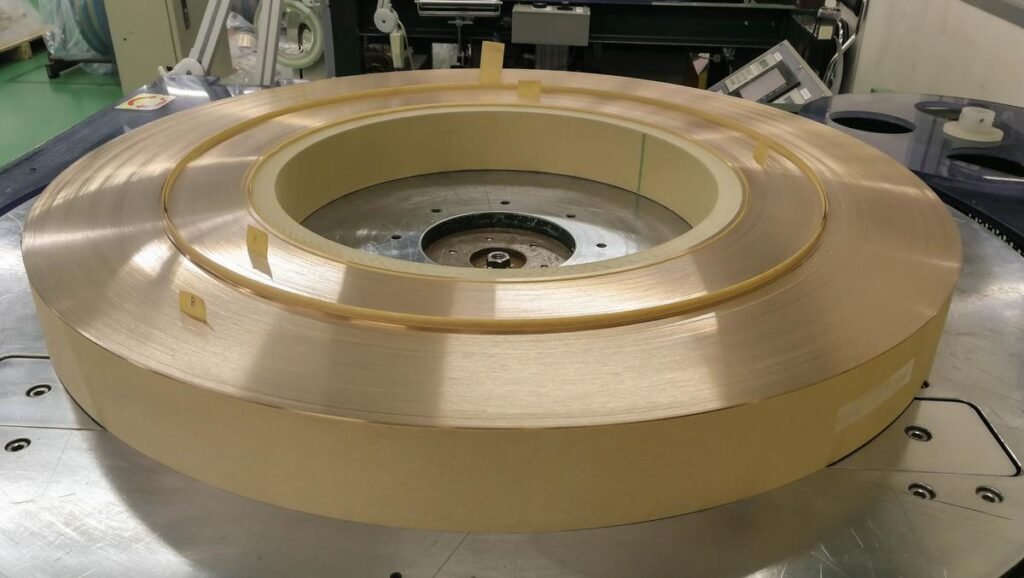Lead frames, while pivotal in semiconductor packaging, come with a set of complexities that often go unnoticed. Delving deeper, we uncover the nuances that make this component so crucial.
A lead frame is a thin metal plate part used in semiconductor packages, such as IC and LSI, acting as a foundation for the chip and facilitating connections.
To truly appreciate the significance of lead frames, we must explore the subtle intricacies and challenges they present.


The Role and Basics of Lead Frames
In the intricate world of semiconductor packaging, lead frames stand out as foundational components that play a pivotal role. These thin metal plates, often overlooked, are the backbone of semiconductor packages such as IC and LSI. Their primary function is to provide a solid base for the chip and facilitate its connections, ensuring seamless communication within the device. But what makes them so essential, and what are the considerations when designing them?
Fundamentals of Lead Frames
Lead frames are more than just metal plates; they are precision-engineered components designed to support the semiconductor chip and connect it to the external circuit. Their design and layout are crucial as they determine how effectively the chip can communicate with the outside world. The pins or leads of the frame not only provide physical support but also act as conduits for electrical signals, powering the chip and transmitting data. Given their importance, understanding the basics of lead frames is essential for anyone involved in semiconductor design or manufacturing.
Material Nuances
The choice of material for a lead frame is not arbitrary. Different metals and alloys come with their own sets of properties, and the right choice can significantly impact the performance of the semiconductor package. Primarily, metals like copper, iron-nickel alloys, and aluminum are preferred due to their excellent conductivity. However, it’s not just about conductivity. Corrosion resistance is another vital factor. A lead frame that corrodes easily can compromise the chip’s performance and lifespan. Therefore, materials are often chosen based on a balance between conductivity, corrosion resistance, and other factors like cost and availability.
Thermal Management
Heat is a constant challenge in the world of electronics. As devices become more powerful and compact, managing heat becomes even more critical. Lead frames play a crucial role in this aspect. Their design must ensure effective heat dissipation, preventing the chip from overheating and ensuring optimal performance. This is where the material choice again comes into play, as metals with high thermal conductivity can help in dissipating heat more effectively. However, it’s not just about the material. The design of the lead frame, its thickness, and its layout can all influence how well it manages heat. Moreover, in environments with high temperatures, the lead frame must be robust enough to withstand the heat without deforming or losing its properties.

Advantages and Challenges of Using Lead Frames
Lead frames, while seemingly simple, are integral to the functionality and efficiency of semiconductor packages. Their design and integration can significantly influence the performance of the entire device. However, as with any component, they come with their own set of advantages and challenges, especially in an industry that constantly evolves and demands innovation.
Performance Enhancement
One of the primary advantages of using lead frames is the significant boost they provide to the performance of semiconductor packages. By ensuring a stable and efficient connection between the chip and the external circuit, lead frames facilitate faster data transmission and reduce signal loss. Their design, especially the layout and spacing of the leads, can optimize signal pathways, minimizing interference and ensuring clearer communication. Moreover, by aiding in effective heat dissipation, they ensure that the chip functions optimally without overheating, thereby prolonging the lifespan of the device.
The Drive for Miniaturization
As technology advances, there’s a relentless push towards making devices smaller, more compact, and more efficient. This drive for miniaturization presents both an opportunity and a challenge for lead frame design. On one hand, smaller devices mean lead frames need to be more precise, compact, and intricately designed. This can lead to challenges in ensuring that the lead frames are still robust, efficient, and capable of managing heat effectively. On the other hand, it pushes innovation, leading to the development of new materials, designs, and manufacturing techniques that can meet these demands.
Integration Complexities
Integrating lead frames seamlessly into semiconductor packages is no small feat. The challenge lies not just in ensuring that the lead frame fits perfectly but also in ensuring that it interfaces effectively with other components. Connection techniques need to be precise to prevent any misalignment or loose connections, which can compromise the device’s performance. Additionally, as semiconductor packages become more complex, integrating lead frames without interfering with other components or pathways becomes a delicate balancing act. This requires a deep understanding of the entire device’s architecture and a holistic approach to design.

Stamping Solutions for Lead Frames
Stamping, a manufacturing process that employs dies to shape metal sheets, plays a pivotal role in the production of lead frames. As the semiconductor industry evolves, so do the techniques and methodologies associated with stamping, ensuring that lead frames meet the stringent requirements of modern devices.
Introduction to Stamping in Lead Frames
Stamping is a widely adopted method for producing lead frames. It involves using a die, which is a specialized tool, to shape metal sheets into the desired form. This process ensures that each lead frame is consistent in shape and size, which is crucial for the reliable performance of semiconductor packages. Given the precision and scalability that stamping offers, it’s no wonder that it’s the go-to method for lead frame production.
Advantages of Stamping for Lead Frames
The stamping process offers a plethora of benefits when it comes to lead frame production. Firstly, it ensures precision, guaranteeing that each lead frame is identical, which is vital for mass production. Additionally, stamping is cost-effective, especially when producing lead frames in large quantities. The process is also adaptable, allowing for modifications in design without significant overhauls in the production line.
Challenges and Solutions in Stamping
While stamping is advantageous, it’s not without its challenges. Material wastage, equipment maintenance, and ensuring consistent quality can pose issues. However, with advancements in technology, solutions like precision dies, advanced monitoring systems, and automated quality checks have been developed to address these challenges, ensuring that the stamping process remains efficient and reliable.

Case Study: Advanced Stamping Techniques
One notable example is the approach adopted by Texas Instruments, a renowned semiconductor manufacturer. They implemented advanced stamping techniques to improve the quality and efficiency of their lead frames. By integrating precision dies with real-time monitoring systems, Texas Instruments was able to reduce material wastage and enhance the consistency of their lead frames. This not only led to cost savings but also improved the overall performance of their semiconductor packages.
Future Trends in Stamping
As the demand for more compact and efficient semiconductor devices grows, the stamping process will inevitably evolve. Emerging technologies, such as nano-stamping and hybrid stamping methods, promise to revolutionize lead frame production. Additionally, the integration of AI and machine learning in stamping processes is expected to further enhance precision and reduce errors, setting the stage for the next generation of lead frames.

Cost Implications and Sustainability
In the rapidly evolving semiconductor industry, the balance between cost, performance, and sustainability is paramount. As the demand for advanced electronic devices grows, so does the need for efficient and sustainable manufacturing processes. Lead frames, being at the heart of semiconductor packages, are no exception to this trend.
Balancing Cost and Performance
The production of lead frames is a delicate dance between ensuring top-notch performance and managing costs. High-quality materials and precision manufacturing techniques, while essential for optimal performance, can drive up production costs. However, cutting corners to save costs can compromise the reliability and efficiency of the semiconductor package.
Manufacturers often employ strategies such as bulk purchasing of raw materials, investing in advanced machinery that reduces wastage, and continuous process optimization to strike the right balance. The goal is to produce lead frames that not only meet the performance requirements but also are cost-effective, ensuring that the final semiconductor products remain competitive in the market.
Sustainable Manufacturing
The push for sustainability in manufacturing is more significant than ever. With growing concerns about environmental degradation and resource depletion, the semiconductor industry is under pressure to adopt eco-friendly practices. For lead frame production, this means several things:
- Material Selection: Opting for materials that are abundant, recyclable, and have a lower environmental footprint. For instance, using alloys that require less energy-intensive refining processes or materials that are sourced responsibly.
- Waste Reduction: Implementing manufacturing processes that minimize wastage. This includes optimizing stamping techniques to reduce scrap metal and recycling waste materials wherever possible.
- Energy Efficiency: Investing in machinery and equipment that consume less power and optimizing manufacturing processes to be energy-efficient.
- Recyclable Designs: Designing lead frames in a way that they can be easily recycled at the end of their lifecycle. This not only reduces the environmental impact but also offers potential cost savings in the long run as recycled materials can be reused.

Real-World Applications and Case Studies of Lead Frames
Lead frames, while seemingly minute components, play a pivotal role in the functionality of a myriad of devices. Their significance becomes even more pronounced when we delve into real-world applications and observe the challenges and innovations associated with them.
Miniaturization in Mobile Devices
The smartphone revolution has been nothing short of spectacular. As these devices become more powerful, the demand for compact and efficient semiconductor components has skyrocketed. Apple, for instance, with its iPhone series, has consistently pushed the envelope in terms of device miniaturization. The A14 Bionic chip, used in the iPhone 12 series, is a testament to this drive. Built using a 5nm process, it packs 11.8 billion transistors. The lead frames in such chips are intricately designed to support this level of miniaturization while ensuring optimal performance.
Sustainable Manufacturing in Automotive
The automotive industry is undergoing a transformative shift towards electric vehicles (EVs). Companies like Tesla are at the forefront of this change. Tesla’s Model 3, for example, relies heavily on advanced semiconductor components to manage its battery system, drive train, and infotainment systems. The lead frames in these components are not only designed for performance but also with sustainability in mind. Tesla’s commitment to reducing its carbon footprint means that the materials and manufacturing processes for these lead frames are chosen based on their environmental impact, pushing for more sustainable practices in semiconductor manufacturing.
Cost-Effective Solutions in Consumer Electronics
The consumer electronics market is fiercely competitive, with companies constantly vying for a larger market share. Samsung, a global leader in consumer electronics, is known for its innovative yet cost-effective products. The Galaxy series of smartphones, for instance, offers a range of devices catering to various price points. The semiconductor components in these devices, supported by efficiently designed lead frames, are a testament to Samsung’s ability to balance performance, cost, and reliability. By optimizing the lead frame manufacturing process, Samsung ensures that its devices remain competitive in terms of price without compromising on quality.

Conclusion
In the intricate world of semiconductor manufacturing, lead frames, often overshadowed by more prominent components, stand as unsung heroes. These seemingly simple structures play a pivotal role in ensuring that our modern electronic devices, from smartphones to electric vehicles, function optimally. Their significance is underscored by the myriad of challenges and innovations associated with their design and production.
The balance between cost, performance, and sustainability is a testament to the complexities involved in lead frame manufacturing. As we’ve seen, whether it’s the drive for miniaturization in mobile devices or the push for sustainable solutions in the automotive sector, lead frames are at the heart of these technological advancements.
Moreover, real-world applications and case studies from industry giants like Apple, Tesla, and Samsung highlight the continuous innovation in lead frame design and manufacturing. These companies, in their quest for perfection, push the boundaries of what’s possible, ensuring that lead frames evolve in tandem with the ever-growing demands of the semiconductor industry.
In conclusion, as we stand on the cusp of a new era of technological advancements, the importance of lead frames cannot be overstated. Their role in the semiconductor industry is set to grow, and with it, the need for continuous innovation, ensuring that they remain relevant and efficient in the face of ever-evolving challenges.


